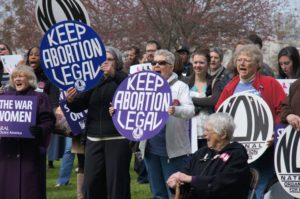 The Supreme Court made abortion legal in the United States 48 years ago, when Roe v. Wade was decided on January 22, 1973. In a 7-2 decision, the court ruled that a woman’s right to choose an abortion was protected by the privacy rights guaranteed by the Fourteenth Amendment to the U.S. Constitution. Justice Ruth Bader Ginsburg (RBG) “was not that fond of Roe v. Wade as a decision,” because “she believed the landmark ruling was too sweeping and vulnerable to attacks,” according to Professor Mary Hartnett, who co-authored a biography of Justice Ginsburg. She was right! Legal abortion has been under attack since it was legalized in 1973, and those attacks have ramped up in North Carolina since 2011. Yet abortion is extremely safe, as shown. See aspects of the history of abortion in North Carolina from 1973 to 2020.
The Supreme Court made abortion legal in the United States 48 years ago, when Roe v. Wade was decided on January 22, 1973. In a 7-2 decision, the court ruled that a woman’s right to choose an abortion was protected by the privacy rights guaranteed by the Fourteenth Amendment to the U.S. Constitution. Justice Ruth Bader Ginsburg (RBG) “was not that fond of Roe v. Wade as a decision,” because “she believed the landmark ruling was too sweeping and vulnerable to attacks,” according to Professor Mary Hartnett, who co-authored a biography of Justice Ginsburg. She was right! Legal abortion has been under attack since it was legalized in 1973, and those attacks have ramped up in North Carolina since 2011. Yet abortion is extremely safe, as shown. See aspects of the history of abortion in North Carolina from 1973 to 2020.
On Abortion
Legislative attacks continue even though abortion is pretty common and very safe. About 1 in 4 (24% in 2014) American women will have had an abortion by age 45, according to the Guttmacher Institute, a leading sexual and reproductive health research and policy organization. Fifty-nine percent of women who have abortions have already given birth, according to Guttmacher. Abortion is much safer than staying pregnant. Pregnancy is a medical condition, and it can be a very dangerous one. Pregnant women risk diseases like diabetes, hypertension, heart failure, seizures and more.
Being pregnant is even more dangerous if you’re a Black or Native American woman. Black women are three times more likely to die from pregnancy-related causes than white women (41.7% vs. 13.4%), according to the Centers for Disease Control and Prevention. Non Hispanic American Indian or Alaska Native women are more than twice as likely to die from pregnancy related causes than white women (28.3% vs. 13.4%). Experts say the reasons behind the racial disparities are many and complex. Lack of access and poor quality of care are leading factors, particularly among women at lower socioeconomic levels. However, affluent superstars like Beyoncé and Serena Williams both experienced life-threatening complications in their pregnancies in 2017. Williams experienced a pulmonary embolism a day after giving birth. She recognized the symptoms and her concerns were still initially dismissed! A division of the National Academy of Sciences published a report exploring implicit bias and structural racism affecting how women are treated by health care professionals, called “Unequal Treatment: Confronting Racial and Ethnic Disparities in Health Care.”
Pregnancy greatly impacts women’s lives in other ways. As Sarah Weddington argued in Roe v Wade, “A pregnancy to a woman is perhaps one of the most determinative aspects of her life. It disrupts her body. It disrupts her education. It disrupts her employment. And it often disrupts her entire family life.”
Abortion Access 1973 to the 2010 Elections
Abortion access in North Carolina wasn’t bad for the South through 2010. There was an arbitrary and unconstitutional 20-week abortion ban imposed in 1973. Other laws in the 1970s restricted abortion procedures to certain medical professionals (physicians) and certain facilities (hospitals and licensed clinics).
Nationally, the Hyde Amendment has blocked federal Medicaid funding for abortion services since 1976. Starting in 1994, three exceptions were allowed to be funded by Medicaid – when continuing the pregnancy will endanger the patient’s life, or when the pregnancy results from rape or incest. Medicaid is America’s health coverage program for poor and low-income people, most of whom are women.
In 1978, Governor Jim Hunt made North Carolina the only state in the South with a fund to pay for abortions in the first twenty weeks of pregnancy. The amount in the fund changed over time. In 1993, the fund was increased to over a million dollars a year. However, in 1995, the NC General Assembly made the fund mostly inaccessible. For the next decade, the state abortion fund was deliberately underfunded, but was very hard to access anyway. The state abortion fund was removed from the state budget in 2011.
North Carolina imposed a parental consent law on minors. According to NARAL Pro-Choice, “In 1977, the General Assembly passed a law stating that minors could not consent to an abortion. In 1995, the General Assembly allowed that minors could get an abortion, but only with written parental consent, or petition the court for a judicial bypass to that consent.” So minors who get pregnant and can’t get permission from their parents need to navigate the legal system to get a judge to give them permission to get an abortion. In addition, the extra time this takes makes the abortion cost more, as abortions cost more later in the pregnancy. This is an expense for a young woman who most likely isn’t getting the money from her parents who she is unwilling or afraid to tell she’s pregnant. Also consider how stressful this is for a young person to have to navigate the judicial system, and may have to do it on her own.
Change in Abortion Access Since 2010 Elections
Blocking the state abortion fund, arbitrary abortion bans and parental consent laws show why Guttmacher classified North Carolina as leaning hostile to abortion in 2000 and 2010. Women lost more ground following 2010 elections, especially in Southern states like North Carolina, and in the Midwest. Extremist Conservatives took over the NC House and Senate in 2011. The Democratic governor, Bev Perdue, was somewhat moderate, but the bills coming from the NC legislature were so extreme that she vetoed fifteen of them in one year! In 2011, vetoing 15 bills was vetoing “five more than had been issued combined in the 14 years since governors first got the power to reject bills,” according to the Greensboro News and Record. The Conservatives put all of their new abortion restrictions into an omnibus anti-abortion bill, ironically called the “Woman’s Right to Know Act”, WRTK, which among other things, required women considering abortion to listen to anti-abortion rhetoric provided by politicians, required an invasive internal vaginal ultrasound “at least 4 hours” before an abortion, and added a requirement to wait 24 hours “before making a decision” which meant waiting at least 24 hours before having an abortion after going to the clinic. Although Perdue vetoed the bill, the legislature passed it by overriding her veto. WRTK became law on July 28, 2011.
More restrictions were added in the next long session, which was 2 years later. Many North Carolina women and allies remember dramatic events of 2013 to try to stop or ameliorate bad anti-abortion legislation. It began with a “Not In Her Shoes” rally at Halifax Mall that was cosponsored by Planned Parenthood, NC NOW and Naral Pro-Choice NC and others. Women came from around the state, joined by many pro-choice legislators. Read more about the event with NC Policy Watch, at “Reproductive Freedom Advocates Rally Today,” 3/20/2013.
Motorcycle-Vagina Bill of 2013
Later in 2013, there was the travesty of the Motorcycle-Vagina Bill. A standalone bill with abortion restrictions had passed the Senate, and pro-choice advocates and legislators were watching for it to go to the House on Jun 27, so they could protest it, try to make it less bad, etc. Lawmakers decided to go to extremes to hide it, so they took a motorcycle helmet bill that had been languishing and put the anti-abortion changes in there. The deception was finally noticed, and pro-choice advocates were incensed! Many protesters wore pink or purple, some wore motorcycle helmets, and a group of five women were prominent in the House Gallery wearing T-shirts spelling out “S H A M E.”
The Motorcycle-Vagina bill, SB 353 placed new requirements on women’s health clinics that could make it difficult for many of them to stay open, and would allow the state’s health department to create temporary rules for North Carolina’s abortion clinics as it saw fit. These laws that target restrictions on abortion providers are known as TRAP laws, and they create expensive and medically unnecessary regulations for abortion clinics that are written with the goal of forcing them to shut down. The Motorcycle-Vagina bill also prohibits government-administered insurance plans (including the Affordable Care Act) to pay for abortions. Originally they tried to require a doctor to be present when a patient is administered abortion-inducing drugs.
Monday, July 29, 2013, was a big day. The rally followed the passing of the infamous Motorcycle-Vagina bill, and a state budget which hurt teachers and students in many ways. The 13th Moral Monday protest rally that day had the largest turn-out to that date. Coverage was national! The Huffington Post reported “Moral Monday turnout surges In North Carolina” protesting “the GOP agenda.” The state budget had no raises for the state’s teachers, who were already among the lowest-paid in the country, effectively ended teacher tenure and started the terrible school voucher system which siphons taxpayer money for private and often religious schools. After the demonstration, then Governor McCrory signed the anti-abortion bill into law. McCrory signed the anti-abortion bill even though he said he wouldn’t sign any additional restrictions on abortion into law during a gubernatorial campaign debate in October, 2012.
In December 2014, a federal court blocked enforcement of the part of the law forcing physicians and other health care workers to read the state sponsored script. In 2011, organizations sued to stop WRTK under the case of Stuart v. Camnitz. Forcing doctors to read the state sponsored script “serves no medical purpose and disrespects women as decision-makers by subjecting them to paternalistic “protections” by the state.” The ultrasounds are still required.
Anti-Choice Changes in 2015
There were multiple bills associated with anti-choice changes in 2015. Former Governor McCrory signed three of them into law – another WRTK bill interfering with safe and legal abortion, one pulling funds from Planned Parenthood, and one interfering with sex education in schools
Part of the 2015 WRTK bill extended the waiting period from 24 to 72 hours and added physician reporting requirements. Physicians who provide abortion care to a woman after 16 weeks must convey numerous statistics to the Department of Health and Human Services, including an ultrasound image and fetal measurements. Earlier versions of the bill showed tracking of ultrasounds at 18 weeks, and suddenly that became 16 weeks in a later version. Earlier versions of the bill also tried to ban abortions (with few exceptions) in facilities connected to the UNC and East Carolina University medical schools, and would have ended a well-respected Gynecology program.
On Crisis Pregnancy Centers (CPCs)
Another important aspect of abortion access is the sheer numbers of abortion clinics vs. anti-abortion clinics, also known as Crisis Pregnancy Centers (CPC). There are more than 110 CPCs in North Carolina, and 15 abortion clinics available as of December 2020. The abortion clinics were limited to 9% of the 100 counties in North Carolina in 2017, all in urban areas.
NC Taxpayer Money Supporting CPCs Since 2013
To make matters worse, the North Carolina General Assembly is directing taxpayer money to anti-abortion organizations and clinics. In 2013, the NCGA allocated $250K in the budget to support their services. That number has gone up each budget cycle, to $1.55 million annually in the 2018 budget. They allocated $2.6 million in 2019, but that part of the budget wasn’t passed. UNC law professor Gene Nichol found out about taxpayer money subsidizing CPCs and used his July 1 2019 column to explain how “Funding NC crisis pregnancy centers is government sponsored religion” and violates the First Amendment.
#StopTheBans in 2019
There was some good news in 2019 – North Carolina’s 20 week abortion ban was struck down as unconstitutional. However, the news was overshadowed by the wave of abortion bans around the country in 2019. NC was one of many states where legislators proposed abortion bans. By May 2019, Alabama, Arkansas, Georgia, Kentucky, Mississippi, Missouri, Ohio, and Utah all had passed abortion ban bills. Women and allies around NC quickly set up rallies around May 19 to fight back against these unconstitutional attempts to gut Roe, control women, and punish doctors. By the end of 2019, Guttmacher reported that conservative state legislators signed 25 new abortion bans into law, primarily in the South and Midwest.
Turning NC Around
North Carolina is definitely hostile to abortion now, as shown by the many restrictions added since 2011, the limited number of abortion clinics, the limited areas which have clinics, and legislature funneling taxpayer money to anti-abortion organizations and individual CPCs. All this despite how safe abortion is. Many women and allies were hoping for more change in the legislature and council of state positions in the 2020 elections to stop the attacks on abortion access and help women and families in other ways. It’s certainly do-able. Virginia has done a wonderful turnaround! A record number of progressive women were elected to the Virginia legislature in 2018 and 2020, and they rolled back multiple abortion restrictions. In fact last April, the Virginia governor managed to sign abortion protections into law. North Carolina needs more progressives in office to free women to control their own bodies and change the priorities of the legislature to support women and families. Another approach to stop the waves of abortion restrictions is to change federal law with something like the Women’s Health Protection Act of 2019. Having both more federal protection and more progressive state lawmakers would be great for ensuring women’s control over their own medical decisions and their bodies.
Resources
- “The End of the North Carolina Abortion Fund,” January 1999, https://core.ac.uk/download/pdf/232783104.pdf
- “Unequal Treatment: Confronting Racial and Ethnic Disparities in Health Care.” 2003, National Center for Biotechnology Information, https://pubmed.ncbi.nlm.nih.gov/25032386/
- “N.C. House Budget Tackles Taxpayer-Funded Abortions,” 5/3/11, https://www.carolinajournal.com/news-article/n-c-house-budget-tackles-taxpayer-funded-abortions/
- “Perdue vetoes bill requiring waiting period for abortions,” 6/27/11, http://pulse.ncpolicywatch.org/2011/06/27/perdue-vetoes-bill-requiring-waiting-period-for-abortions/
- “North Carolina Woman’s Right to Know Act (HB 854),” Rewire News Group, 2011, https://rewirenewsgroup.com/legislative-tracker/law/north-carolina-womans-right-to-know-act-hb-854/
- “Stuart v. Camnitz,” 2011, Rewire News Group, https://rewirenewsgroup.com/legislative-tracker/legal-case/stuart-v-camnitz/
- “Perdue vetoes 4 more bills,” 6/30/11, Greensboro News & Record, https://greensboro.com/news/political/perdue-vetoes-more-bills/article_0baa4f94-d6ff-5f1a-a421-1e9aa098a147.html
- “Perdue vetoes bill requiring waiting period for abortions,” 6/27/11, NC Policy Watch, http://pulse.ncpolicywatch.org/2011/06/27/perdue-vetoes-bill-requiring-waiting-period-for-abortions/#sthash.40XEKY6n.dpbs
- “Reproductive freedom advocates rally today (Video),” 3/20/13, NC Policy Watch, http://pulse.ncpolicywatch.org/2013/03/20/reproductive-freedom-advocates-rally-today-video/#sthash.9h5JfNGj.dpbs
- Text of the Motorcycle-Vagina Bill, SB 353, 2013, https://www.ncleg.gov/Sessions/2013/Bills/Senate/PDF/S353v5.pdf
- “Pat McCrory Signs Controversial Abortion Bill Into Law,” 7/30/13, https://www.huffpost.com/entry/pat-mccrory-abortion-bill_n_3673393
- “Moral Monday Turnout Surges In North Carolina As Largest Crowd Yet Once Again Protests GOP Agenda,“ 7/30/13, https://www.huffpost.com/entry/moral-monday-north-carolina-protest_n_3676125
- “NC’s anti-choice changes in 2015,” 12/12/15, NC NOW, https://northcarolinanow.wordpress.com/2015/12/12/ncs-anti-choice-changes-in-2015/
- “Why are black women at such high risk of dying from pregnancy complications?” 2/20/19, https://www.heart.org/en/news/2019/02/20/why-are-black-women-at-such-high-risk-of-dying-from-pregnancy-complications
- “Federal Judge Blocks North Carolina Ban On Abortions Later Than 20 Weeks,” 3/27/19, NPR, https://www.npr.org/2019/03/27/707073400/federal-judge-blocks-north-carolina-abortion-ban-after-20-weeks
- “US and NC Abortion Bans: What Are We Looking At? ,” 5/20/19, NC NOW, https://northcarolinanow.wordpress.com/2019/05/20/us-and-nc-abortion-bans-what-are-we-looking-at/
- “#StopTheBans Event Summaries from Around NC – May 2019,” 5/23/19, NC NOW, https://northcarolinanow.wordpress.com/2019/05/23/stopthebans-event-summaries-from-around-nc-may-2019/
- “Doctors’ organization: calling abortion bans ‘fetal heartbeat bills’ is misleading,” 6/5/19, The Guardian, https://www.theguardian.com/world/2019/jun/05/abortion-doctors-fetal-heartbeat-bills-language-misleading
- “$1.55 Million in Taxpayer Money Going to CPCs in NC Budget,” 5/31/18, https://northcarolinanow.wordpress.com/2018/05/31/1-55-million-in-taxpayer-money-going-to-cpcs-in-nc-budget/
- “Nichol: Funding NC crisis pregnancy centers is government sponsored religion,” 7/1/19, https://www.charlotteobserver.com/opinion/opn-columns-blogs/article232068072.html
- “Over $2.6 Million of 2019 State Budget to CPCs,” 7/25/19, https://northcarolinanow.wordpress.com/2019/07/25/2-6-million-of-2019-state-budget-to-cpcs/
- “Record Support in Congress for Bill to Protect Abortion Access,” 8/1/19, Center For Reproductive Rights, https://reproductiverights.org/press-room/record-support-congress-bill-protect-abortion-access
- Guttmacher: State Abortion Policy Landscape: From Hostile to Supportive, initially posted 8/29/19, Guttmacher, https://www.guttmacher.org/article/2019/08/state-abortion-policy-landscape-hostile-supportive
- “Abortion Incidence and Service Availability in the United States,” September 2019, https://www.guttmacher.org/report/abortion-incidence-service-availability-us-2017
- “State Policy Trends 2019: A Wave of Abortion Bans, But Some States Are Fighting Back,” 12/10/19, Guttmacher, https://www.guttmacher.org/article/2019/12/state-policy-trends-2019-wave-abortion-bans-some-states-are-fighting-back
- “Distance Traveled to Obtain Clinical Abortion Care in the United States and Reasons for Clinic Choice,” 12/10/19, https://www.liebertpub.com/doi/10.1089/jwh.2018.7496
- “Virginia governor signs abortion protections into law,” 4/10/20, CNN, https://www.cnn.com/2020/04/10/politics/virginia-abortion-protections/index.html
- “Why Ruth Bader Ginsburg Wasn’t All That Fond of Roe v. Wade,” 9/21/20, https://www.nytimes.com/2020/09/21/us/ruth-bader-ginsburg-roe-v-wade.html
- “Number of deaths resulting from abortions in the U.S. 1973-2017,” 12/2/20, https://www.statista.com/statistics/658555/number-of-abortion-deaths-us/
- “Planned Parenthood in Missouri disputes report state no longer performs abortions, but number of procedures fell due to new regulations,” 1/20/21, Chicago Tribune, https://www.chicagotribune.com/midwest/ct-missouri-abortions-20210120-36ytfsh37ndcvpt5yjnzan5glm-story.html
- “Abortion Bans in Cases of Sex or Race Selection or Genetic Anomaly,” 2/1/21, Guttmacher,https://www.guttmacher.org/state-policy/explore/abortion-bans-cases-sex-or-race-selection-or-genetic-anomaly
- “State Facts About Abortion: North Carolina,” 3/1/21, Guttmacher.org,
https://www.guttmacher.org/fact-sheet/state-facts-about-abortion-north-carolina - Guttmacher: Induced Abortion in the United States, https://www.guttmacher.org/fact-sheet/induced-abortion-united-states
- “North Carolina Women’s Right to Know Act,” https://en.wikipedia.org/wiki/North_Carolina_Women%27s_Right_to_Know_Act
- “Fake Women’s Health Centers,” https://prochoicenc.org/fake-womens-health-centers/
- Embryo definition, Biology Online, https://www.biologyonline.com/dictionary/embryo
- “Young Women’s Access to Abortion,” NARAL Pro-Choice, https://prochoicenc.org/issues/young-womens-access-abortion/



There are no comments
Add yours